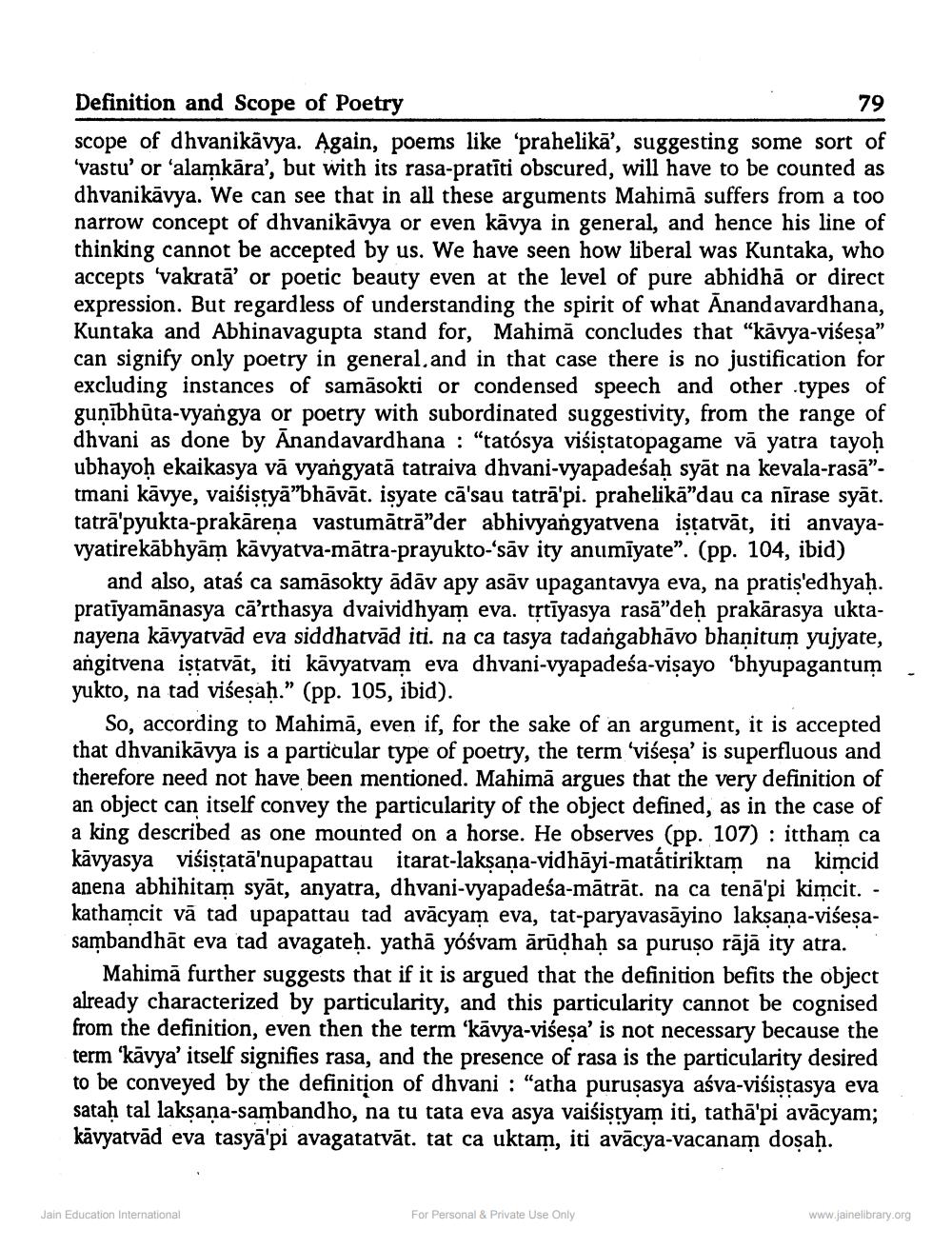________________
Definition and Scope of Poetry
79
scope of dhvanikävya. Again, poems like 'prahelikā', suggesting some sort of 'vastu' or 'alamkāra', but with its rasa-pratiti obscured, will have to be counted as dhvanikāvya. We can see that in all these arguments Mahima suffers from a too narrow concept of dhvanikāvya or even kävya in general, and hence his line of thinking cannot be accepted by us. We have seen how liberal was Kuntaka, who accepts 'vakratā' or poetic beauty even at the level of pure abhidhā or direct expression. But regardless of understanding the spirit of what Anandavardhana, Kuntaka and Abhinavagupta stand for, Mahimă concludes that "kävya-viśesa” can signify only poetry in general and in that case there is no justification for excluding instances of samāsokti or condensed speech and other types of guņībhūta-vyangya or poetry with subordinated suggestivity, from the range of dhvani as done by Anandavardhana : "tatósya višiştatopagame vā yatra tayoh ubhayoh ekaikasya vā vyangyatā tatraiva dhvani-vyapadeśah syāt na kevala-rasā”. tmani kavye, vaišistya'bhāvāt. isyate ca sau tatrā'pi. prahelika"dau ca nīrase syāt. tatrā'pyukta-prakārena vastumātrā"der abhivyangyatvena istatvāt, iti anvayavyatirekābhyām kāvyatva-mātra-prayukto-'sāv ity anumīyate”. (pp. 104, ibid)
and also, ataś ca samāsokty ädāv apy asāv upagantavya eva, na pratis'edhyah. pratiyamānasya cā’rthasya dvaividhyam eva. třtīyasya rasā"deḥ prakārasya uktanayena kāvyatvād eva siddhatvād iti. na ca tasya tadangabhāvo bhanitum yujyate, angitvena istatvāt, iti kävyarvam eva dhvani-vyapadeśa-visayo 'bhyupagantum yukto, na tad višesah.” (pp. 105, ibid).
So, according to Mahimā, even if, for the sake of an argument, it is accepted that dhvanikāvya is a particular type of poetry, the term 'višesa' is superfluous and therefore need not have been mentioned. Mahimā argues that the very definition of an object can itself convey the particularity of the object defined, as in the case of a king described as one mounted on a horse. He observes (pp. 107) : ittham ca kāvyasya višistatā'nupapattau itarat-lakṣaṇa-vidhāyi-matátiriktam na kimcid anena abhihitam syāt, anyatra, dhvani-vyapadeśa-mātrāt. na ca tenā'pi kimcit. - kathamcit vā tad upapattau tad avācyam eva, tat-paryavasāyino laksana-višeșasambandhāt eva tad avagateh. yathā yóśvam ārūdhaḥ sa puruso rājā ity atra.
Mahimā further suggests that if it is argued that the definition befits the object already characterized by particularity, and this particularity cannot be cognised from the definition, even then the term “kāvya-viśesa' is not necessary because the term 'kāvya' itself signifies rasa, and the presence of rasa is the particularity desired to be conveyed by the definition of dhvani : "atha purusasya aśva-viśistasya eva sataḥ tal lakṣaṇa-sambandho, na tu tata eva asya vaiśistyam iti, tathā'pi avācyam; kāvyarvād eva tasyā'pi avagatarvāt. tat ca uktam, iti avācya-vacanam dosah.
Jain Education International
For Personal & Private Use Only
www.jainelibrary.org




